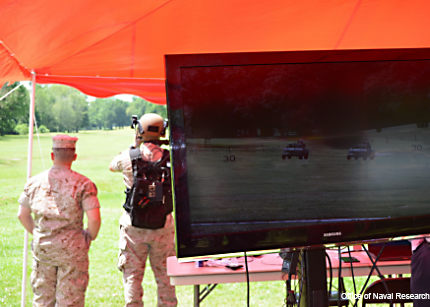Cutting-edge glasses give Marines a clear view of augmented reality
The glasses, developed by ONR, were used for the first time with the Augmented Immersive Team Trainer.

A Marine operates the AITT while a screen displays the view he’s seeing.
Marines recently took another step into the looking-glass world of augmented reality, using new “optical see-through” glasses that helped them make a battlefield out of a golf course.
The glasses, developed by the Office of Naval Research, were connected for the first time to the Augmented Immersive Team Trainer (AITT) at the Marine Corps Base Quantico in Quantico, Va., allowing Marines to train in a live/virtual world that included the real space of the golf course along with virtual tanks, mortar fire and smoke from explosions.
“The glasses are leading-edge and are really pushing the technology of optical see-throughs forward,” Dr. Peter Squire, a program officer with ONR’s Expeditionary Maneuver Warfare and Combating Terrorism Department, said in an ONR news release. “But the glasses are just one component of the system. It’s the AITT system itself that’s revolutionary because it enables warfighters to turn any environment into a training ground.”
The AITT can support any number of live, virtual and constructive training exercises, and continues the push by ONR, the Marine Corps and other military services to make greater use of immersive simulations as part of their training.
The glasses mark a pretty big step in that direction. According to ONR, they’re more technologically advanced than Google Glass and have a wider field of view than similar commercial products. When connected to AITT, they give users an interactive, immersive environment that creates the terrain, buildings, vehicles and people they might run into in a given situation.
ONR drew a distinction between the augmented reality it is using, which combines elements of the real and virtual worlds, and virtual reality, which is contained within a computer-generated environment. Augmented reality allows participants to use their actual gear and equipment while interacting with simulated situations.
That live, virtual and constructive, or LVC, training is a growing focus for the military. The Marines’ Large Scale Exercise in August 2014, for example, mixed live training with virtual and constructive simulations and included both ground and air components at Twentynine Palms, Calif. and Yuma, Ariz., with command and control being handled as far away as Quantico.
released earlier this year